Investigating the Element Geochemical Behavior and Provenance of Surface Sediments in the Offshore Area of Sierra Leone, Africa: Insights from Major and Trace Elements
Abstract
1. Introduction
2. Materials and Methods
2.1. Sample Collection
2.2. Grain Size Analyses
2.3. Major and Trace Element Analyses
3. Results
3.1. Grain Size Characteristics
3.2. Major and Trace Element Contents
4. Discussion
4.1. Correlation Analysis
4.2. Factor Analysis and Provenance Discussion
4.3. Comparison of Element Contents in Sediments from the Research Area and the Offshore Area of China
5. Conclusions
Author Contributions
Funding
Data Availability Statement
Acknowledgments
Conflicts of Interest
References
- Martin, J.; Zhang, J.; Shi, M.; Zhou, Q. Actual flux of the Huanghe (yellow river) sediments to the Western Pacific Ocean. Neth. J. Sea Res. 1993, 31, 243–254. [Google Scholar] [CrossRef]
- Yang, S.; Jung, H.; Lim, D.; Li, C. A review on the provenance discrimination of sediments in the Yellow Sea. Earth Sci. Rev. 2003, 63, 93–120. [Google Scholar] [CrossRef]
- Lim, D.; Kim, J.; Xu, Z.; Jung, H.; Yoo, D.; Choi, M.; Kim, S. Quantitative reconstruction of Holocene sediment source variations in the Yellow and northern East China Seas and their forcings. Mar. Geol. 2020, 430, 106345. [Google Scholar] [CrossRef]
- Li, T.; Rao, W.; Wang, S.; Mao, C. Identifying the clay-size sediment provenance of the radial sand ridges in the southwestern yellow sea using geochemical and Sr-Nd isotopic tracers. Mar. Geol. 2023, 455, 106957. [Google Scholar] [CrossRef]
- Xu, F.; Hu, B.; Dou, Y.; Liu, X.; Wan, S.; Xu, Z.; Tian, X.; Liu, Z.; Yin, X.; Li, A. Sediment provenance and paleoenvironmental changes in the northwestern shelf mud area of the South China Sea since the mid-Holocene. Cont. Shelf Res. 2017, 144, 21–30. [Google Scholar] [CrossRef]
- Zhu, X.; Shen, C.; Zhou, R.; Xu, J.; Zhao, J.; Wang, L.; Ge, X. Paleogene sediment provenance and paleogeographic reconstruction of the South Yellow Sea basin, East China: Constraints from detrital zircon U Pb geochronology and heavy mineral assemblages. Palaeogeogr. Palaeoecl. 2020, 553, 109776. [Google Scholar] [CrossRef]
- Li, M.; Zhu, S.; Ouyang, T.; Tang, J.; He, C. Magnetic fingerprints of surface sediment in the Bohai Sea, China. Mar. Geol. 2020, 427, 106226. [Google Scholar] [CrossRef]
- He, C.; Ouyang, T.; Li, M.; Zhu, S.; Yu, M.; Peng, S.; Zhu, Z.; Wang, Y.; Chen, H.; Tian, C. Nonnegligible contribution of terrigenous sediment inputs from local small watersheds to west regions of the Pearl River Estuary, northern South China Sea shelf. Mar. Geol. 2024, 475, 107369. [Google Scholar] [CrossRef]
- Li, M.; Zeng, Y.; Liu, S.; Tang, M.; Chen, L.; Chen, J.; Amorosi, A.; Ouyang, T. Provenance and sediment dispersal in Pearl River Estuary, southern China unraveled by magnetic properties. Mar. Geol. 2024, 478, 107431. [Google Scholar] [CrossRef]
- Yan, J.; Geng, J.; Su, F. Estimation of the ecosystem service value of the yellow river delta-Laizhou Bay coastal zone considering regional differences and social development. Environ. Manag. 2024, 74, 192–205. [Google Scholar] [CrossRef]
- Lin, C.; Bao, R.; Zhu, L.; Hu, R.; Ji, J.; Yu, S. Surface sediment erosion characteristics and influencing factors in the subaqueous delta of the abandoned yellow river estuary. Mar. Geol. 2024, 468, 107219. [Google Scholar] [CrossRef]
- Wang, F.; Zhang, W.; Nian, X.; Roberts, A.; Zhao, X.; Shang, Y.; Dong, Y. Magnetic evidence for yellow river sediment in the late Holocene deposit of the Yangtze River Delta, China. Mar. Geol. 2020, 427, 106274. [Google Scholar] [CrossRef]
- Saito, Y.; Yang, Z.; Hori, K. The Huanghe (Yellow River) and Changjiang (Yangtze River) deltas: A review on their characteristics, evolution and sediment discharge during the Holocene. Geomorphology 2001, 41, 219–231. [Google Scholar] [CrossRef]
- Wei, X.; Wu, C.; Ni, P.; Mo, W. Holocene delta evolution and sediment flux of the Pearl River, southern China. J. Quaternary Sci. 2016, 31, 484–494. [Google Scholar] [CrossRef]
- Weber, M.E.; Wiedicke, M.H.; Kudrass, H.R.; Hübscher, C.; Erlenkeuser, H. Active growth of the Bengal Fan during sea-level rise and highstand. Geology 1997, 25, 315–318. [Google Scholar] [CrossRef]
- Sun, X.; Liu, S.; Li, J.; Zhang, H.; Shi, X. Major and trace element compositions of surface sediments from the lower Bengal Fan: Implications for provenance discrimination and sedimentary environment. J. Asian Earth Sci. 2019, 184, 104000. [Google Scholar] [CrossRef]
- Yang, S.; Li, C.; Jung, H.; Lee, H. Discrimination of geochemical compositions between the Changjiang and the Huanghe sediments and its application for the identification of sediment source in the Jiangsu coastal plain. China Mar. Geol. 2002, 186, 229–241. [Google Scholar] [CrossRef]
- Liu, J.; Saito, Y.; Kong, X.; Wang, H.; Zhao, L. Geochemical characteristics of sediments as indicators of post-glacial environmental changes off the Shandong peninsula in the Yellow Sea. Cont. Shelf Res. 2009, 29, 846–855. [Google Scholar] [CrossRef]
- Zhu, Y.; Bao, R.; Zhu, L.; Jiang, S.; Chen, H.; Zhang, L.; Zhou, Y. Investigating the provenances and transport mechanisms of surface sediments in the offshore muddy area of Shandong Peninsula: Insights from REE analyses. J. Mar. Syst. 2022, 226, 103671. [Google Scholar] [CrossRef]
- Cheng, P. Sediment Characteristics and Transport Processes of Fine-Grained Material over the Northern Yellow Sea. Ph.D. Thesis, Institute of Oceanology, Qingdao, China, 2000. [Google Scholar]
- Lim, D.; Jung, H.; Choi, J. REE partitioning in riverine sediments around the Yellow Sea and its importance in shelf sediment provenance. Mar. Geol. 2014, 357, 12–24. [Google Scholar] [CrossRef]
- Lan, X.; Chen, X.; Mi, B.; Li, R.; Qin, Y.; Wang, Z. Distribution pattern and source of major and trace elements in the central North Yellow Sea since late Pleistocene. Mar. Geol. Quat. Geol. 2015, 35, 1–10. (In Chinese) [Google Scholar]
- Fang, H.; Huang, P.; Zhou, Y.; Zhang, J.; Li, A.; Yan, J. Distribution and controlling factors of the major elements in surface sediments of the North Yellow Sea. Mar. Sci. 2015, 39, 108–116. (In Chinese) [Google Scholar]
- Li, J.; Liu, S.; Feng, X.; Sun, X.; Shi, X. Major and trace element geochemistry of the mid-Bay of Bengal surface sediments: Implications for provenance. Acta Oceanol. Sin. 2017, 36, 82–90. [Google Scholar] [CrossRef]
- Yang, S.; Youn, J. Geochemical compositions and provenance discrimination of the central south Yellow Sea sediments. Mar. Geol. 2007, 243, 229–241. [Google Scholar] [CrossRef]
- Risgaard-Petersen, N.; Revil, A.; Meister, P.; Nielsen, L. Sulfur, iron-, and calcium cycling associated with natural electric currents running through marine sediment. Geochim. Cosmochim. Acta 2012, 92, 1–13. [Google Scholar] [CrossRef]
- Calvert, S.; Pedersen, T. Geochemistry of recent oxic and anoxic marine sediments: Implications for the geological record. Mar. Geol. 1993, 113, 67–88. [Google Scholar] [CrossRef]
- Dean, W.; Gardner, J.; Piter, D. Inorganic geochemical indicators of glacial-interglacial changes in productivity and anoxia on the California continental margin. Geochim. Cosmochim. Acta 1997, 61, 4507–4518. [Google Scholar] [CrossRef]
- Moskovchenko, D.; Soromotin, A.; Khoroshavin, V.; Prikhodko, N.; Kirillov, V.; Koveshnikov, M.; Krylova, E.; Krasnenko, A.; Pechkin, A. Climate change and the Ob River: A reassessment of major and trace element fluxes to the Arctic Ocean. Water 2024, 16, 2112. [Google Scholar] [CrossRef]
- Grosbois, C.; Desmet, M.; Zhang, M.; Gassama, N.; Battaglia, F. Trace element contamination in one of the Yangtze tributaries (Hunan, China)—Source review and potential release from sediments. Water 2021, 13, 271. [Google Scholar] [CrossRef]
- Bilinski, H. Geochemical fractionation and risk assessment of potentially toxic elements in sediments from Kupa River, Croatia. Water 2020, 12, 2024. [Google Scholar] [CrossRef]
- Cho, Y.; Lee, C.; Cho, M. Geochemistry of surface sediments off the southern and western coasts of Korea. Mar. Geol. 1999, 159, 111–129. [Google Scholar] [CrossRef]
- Lim, D.; Jung, H.; Choi, J.; Yang, S.; Ahn, K. Geochemical compositions of river and shelf sediments in the Yellow Sea: Grain-size normalization and sediment provenance. Cont. Shelf Res. 2006, 26, 15–24. [Google Scholar] [CrossRef]
- Rao, W.; Mao, C.; Wang, Y.; Su, J.; Balsam, W.; Ji, J. Geochemical constraints on the provenance of surface sediments of radial sand ridges off the Jiangsu coastal zone, east China. Mar. Geol. 2015, 359, 35–49. [Google Scholar] [CrossRef]
- Sundaray, S.; Nayak, B.; Lin, S.; Bhatta, D. Geochemical speciation and risk assessment of heavy metals in the river estuarine sediments—A case study: Mahanadi basin, India. J. Hazard. Mater. 2011, 186, 1837–1846. [Google Scholar] [CrossRef]
- Liu, Y.; Kuang, W.; Xu, J.; Chen, J.; Sun, X.; Lin, C.; Lin, H. Distribution, source and risk assessment of heavy metals in the seawater, sediments, and organisms of the Daya Bay, China. Mar. Pollut. Bull. 2022, 174, 113297. [Google Scholar] [CrossRef]
- Liu, T.; Zhu, L.; Bao, R.; Hu, R.; Jiang, S.; Zhu, Y.; Song, J. Hydrodynamically–driven distribution and remobilization of heavy metals in surface sediments around the coastal area of Shandong Peninsula, China. Sci. Total Environ. 2023, 857, 159286. [Google Scholar] [CrossRef]
- Lin, H.; Lan, W.; Feng, Q.; Zhu, X.; Zhao, B. Pollution and ecological risk assessment, and source identification of heavy metals in sediment from the Beibu Gulf, South China Sea. Mar. Pollut. Bull. 2021, 168, 112403. [Google Scholar] [CrossRef]
- McManus, J.; Berelson, W.; Klinkhammer, G.; Johnson, K.; Rushdi, A. Geochemistry of barium in marine sediments: Implications for its use as a paleoproxy. Geochim. Cosmochim. Acta 1999, 62, 3453–3473. [Google Scholar] [CrossRef]
- Folk, R.; Ward, A. Brazos River bar: A study in the significance of grain size parameters. J. Sediment. Res. 1957, 27, 3–26. [Google Scholar] [CrossRef]
- Zhao, J. Elements Geochemistry Spatial Multiscale Variability of Surface Sediments and Its Mechanism in Northwest of the South China Sea. Ph.D. Thesis, China University of Geosciences, Wuhan, China, 2016. [Google Scholar]
- Dou, Y. Characteristics of Sediment Granularity, Element Geochemistry and Their Significance for Identifying Sedimentary Environment in the Contiguous Sea Areas of Changjiang River Estuary. Master’s Thesis, First Institute of Oceanography SOA, Qingdao, China, 2007. [Google Scholar]
- Wang, Q.; Wang, J.; Dong, J.; Zou, L.; Wang, R.; Xie, Y.; Xu, M.; Xie, X.; Zhou, X. Geochemical characteristics and controlling factors of surface sediments in Jiaozhou Bay. Mar. Geol. Front. 2023, 39, 8–19. (In Chinese) [Google Scholar]
- Zhu, Y.; Feng, X.; Zhu, L.; Zhong, W. Origin and geochemistry of surface sediments in the mud deposit area off shore the Shandong Peninsula, China. J. Oceanol. Limnol. 2021, 39, 483–499. [Google Scholar] [CrossRef]
- Lei, Z.; Liu, R.; Hu, R.; Qiu, J.; Zhu, L.; Zhu, F.; Zhang, X. Controlling factors and distribution of geochemical characteristics of the surface sediments in the Yellow River Delta. Mar. Geol. Quat. Geol. 2022, 42, 104–118. (In Chinese) [Google Scholar]
- Jiang, J.; Hu, P.; Zhang, H.; Chen, X.; Wang, J.; Xiang, W. The iron ore resource feature and metallogenic regularity in western Africa. Geol. Bull. China 2023, 42, 1276–1290. [Google Scholar]
- Li, Y.; Yan, H.; Rong, Y.; Lin, J.; Xue, W. The distribution characteristics of mercury species in the estuaries of the ten main rivers in China and flux of mercury from rivers to the ocean. Acta Sci. Circumst. 2022, 42, 323–331. (In Chinese) [Google Scholar]
- Zhang, Z. Evaluation of Sustainable Utilization of Fishery Resources in the Coast of West Africa and Its Development Countermeasures. Ph.D. Thesis, Shanghai Ocean University, Shanghai, China, 2024. [Google Scholar]


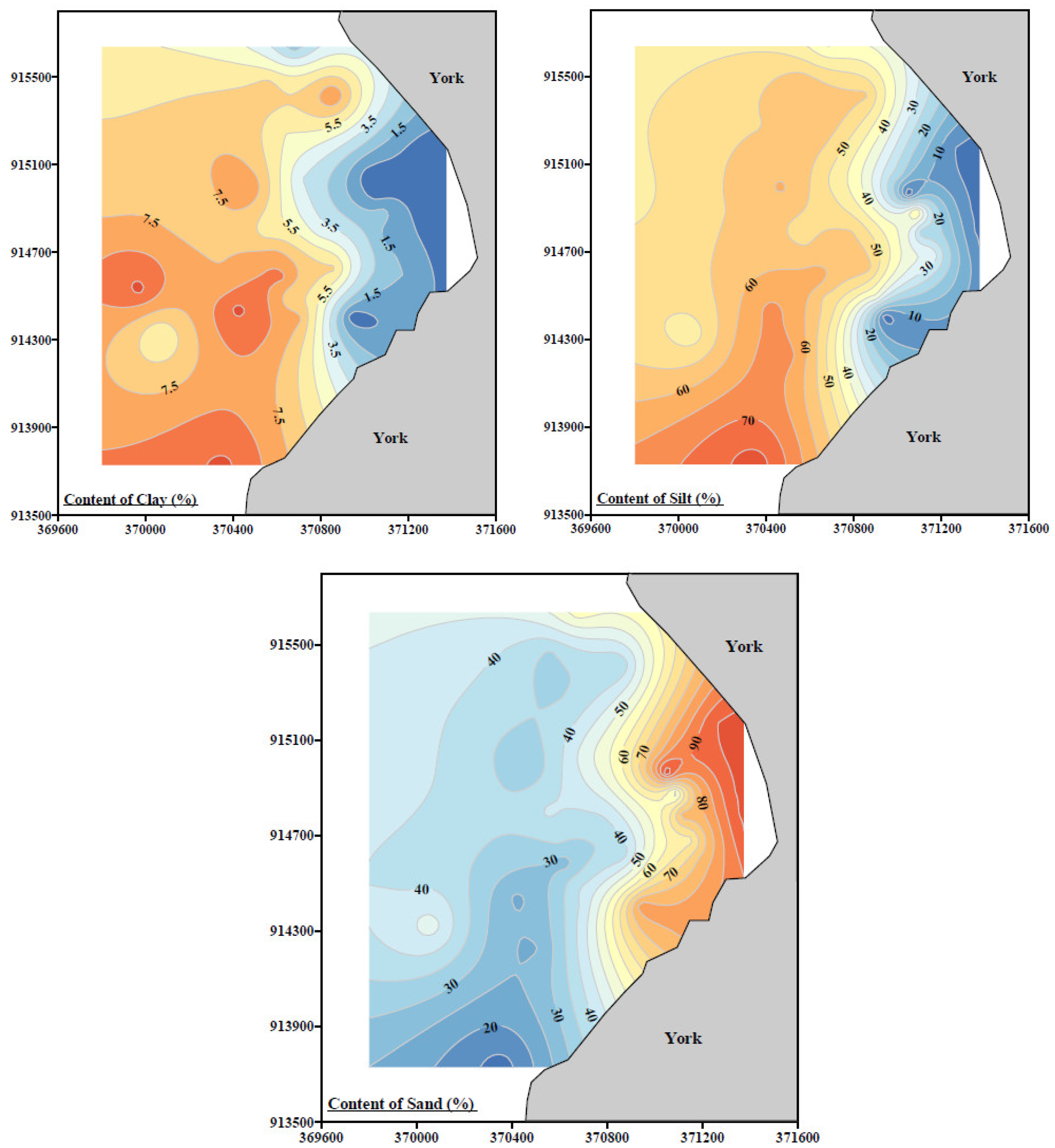
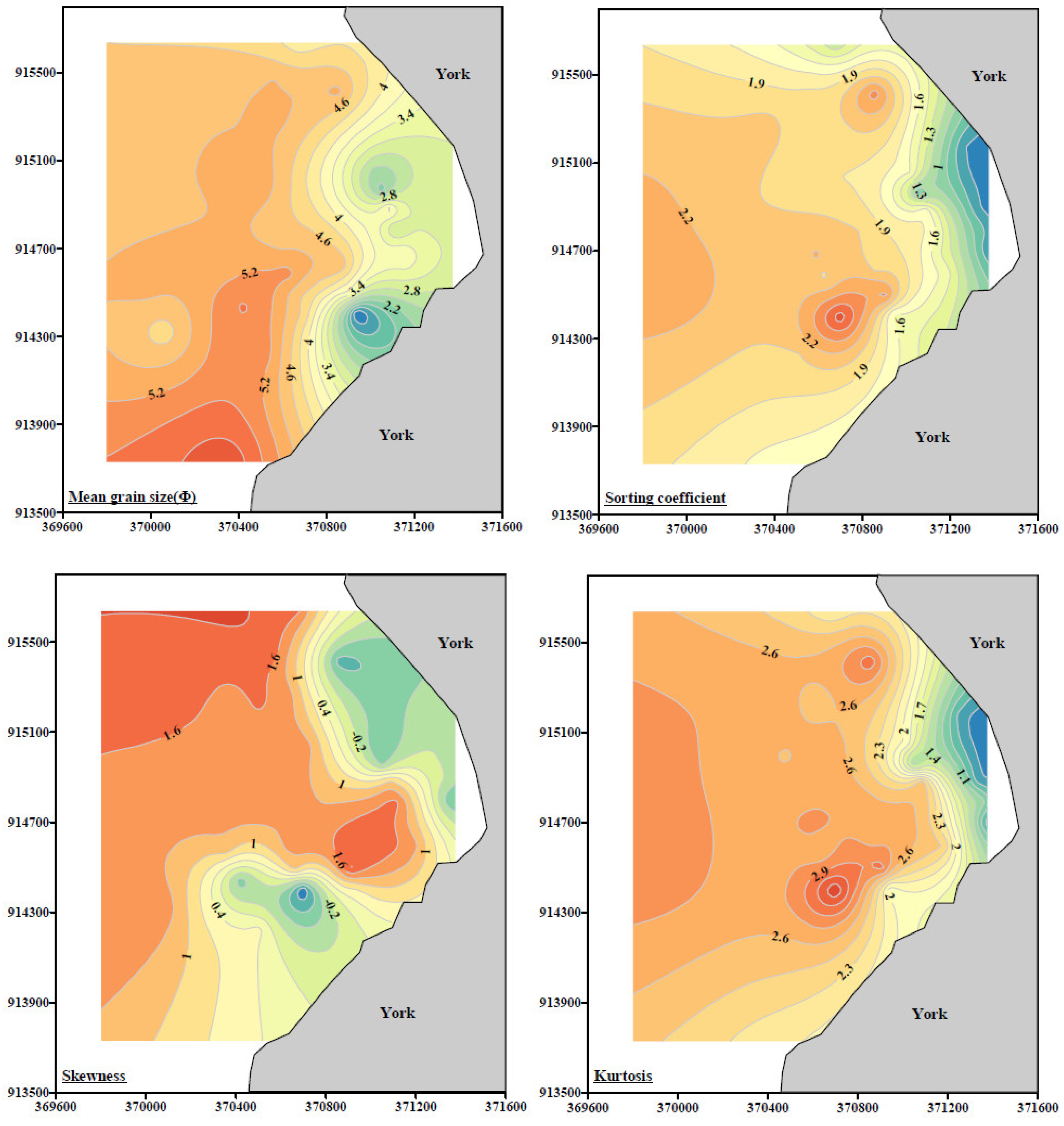

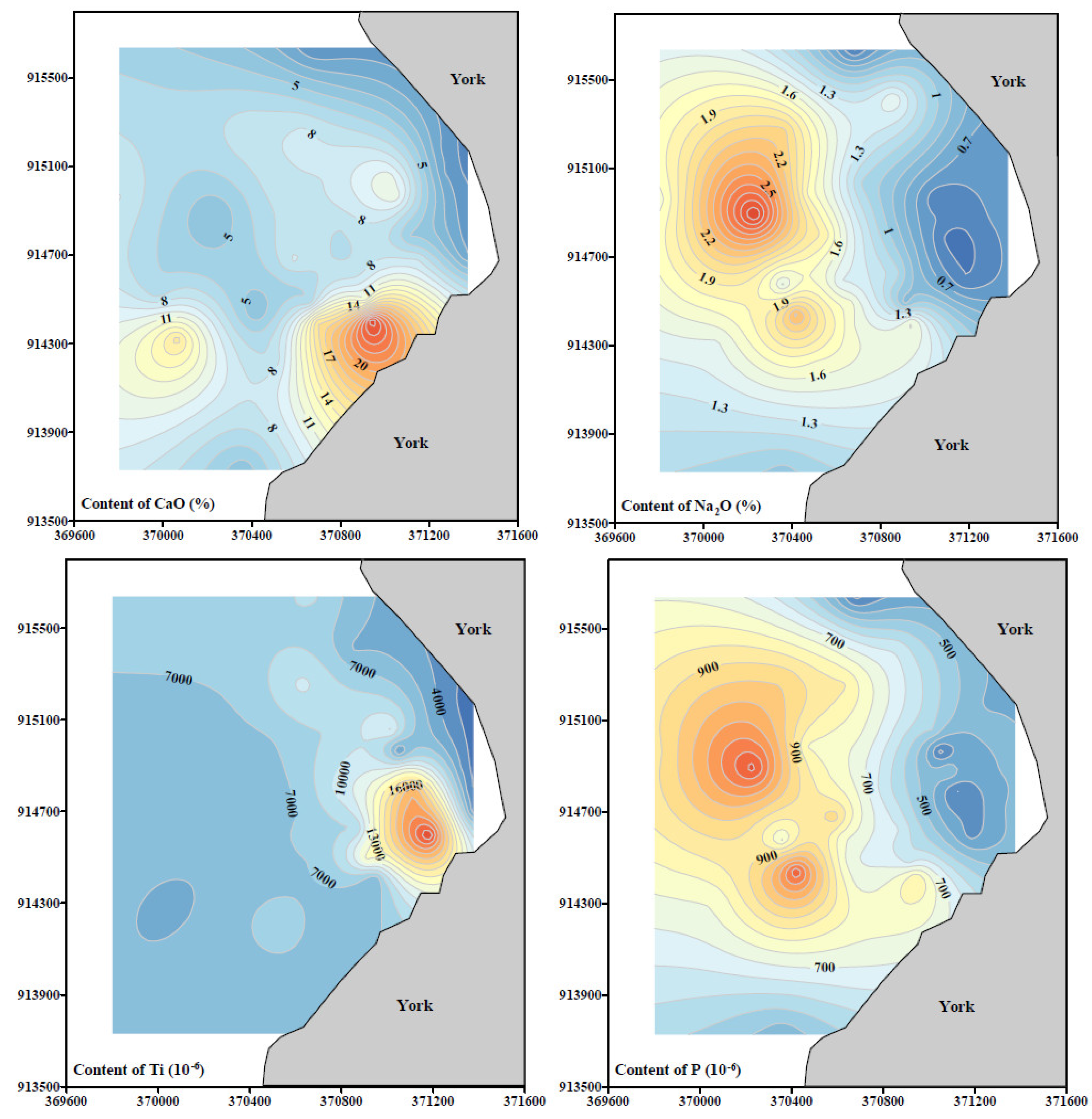

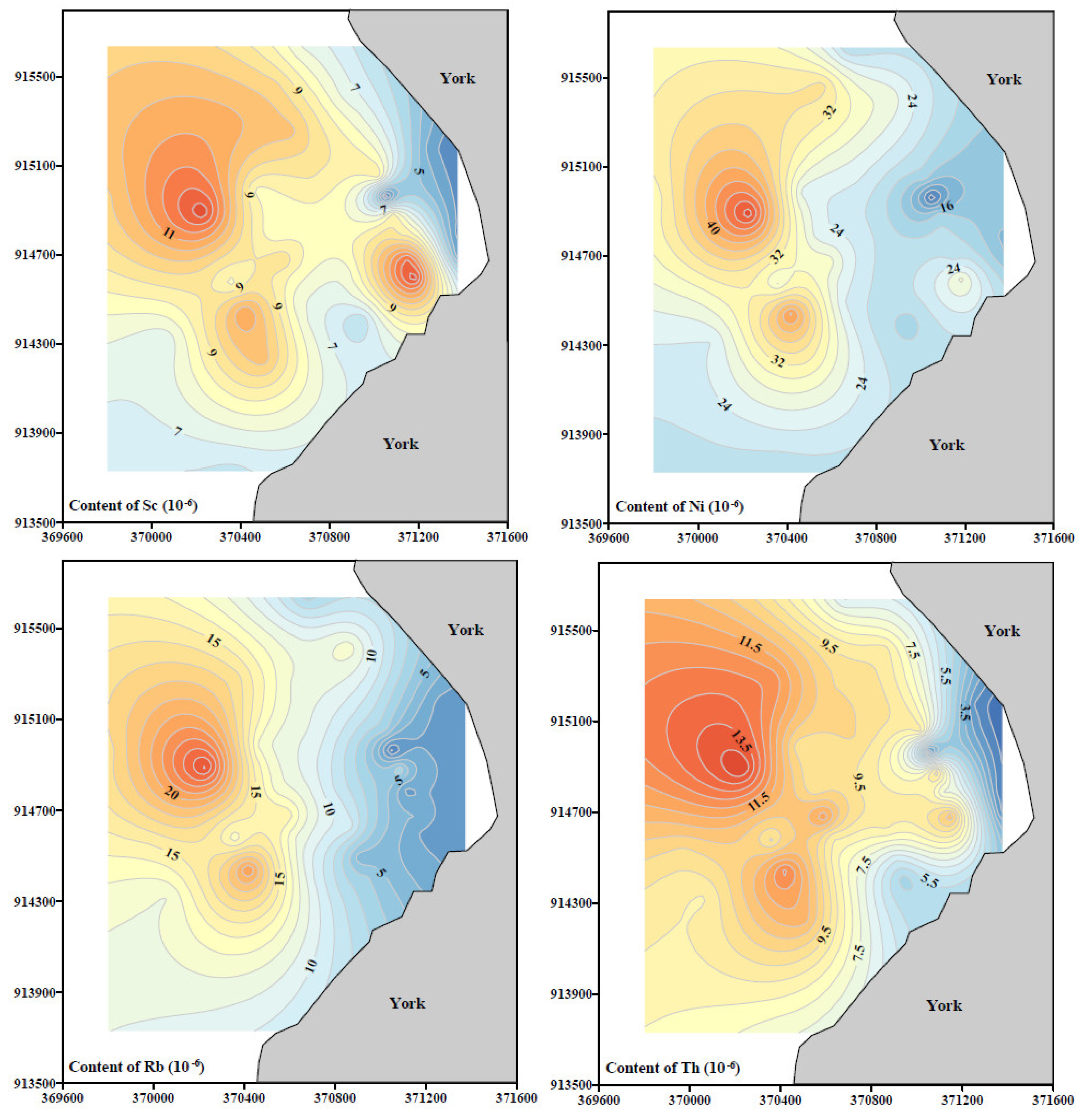
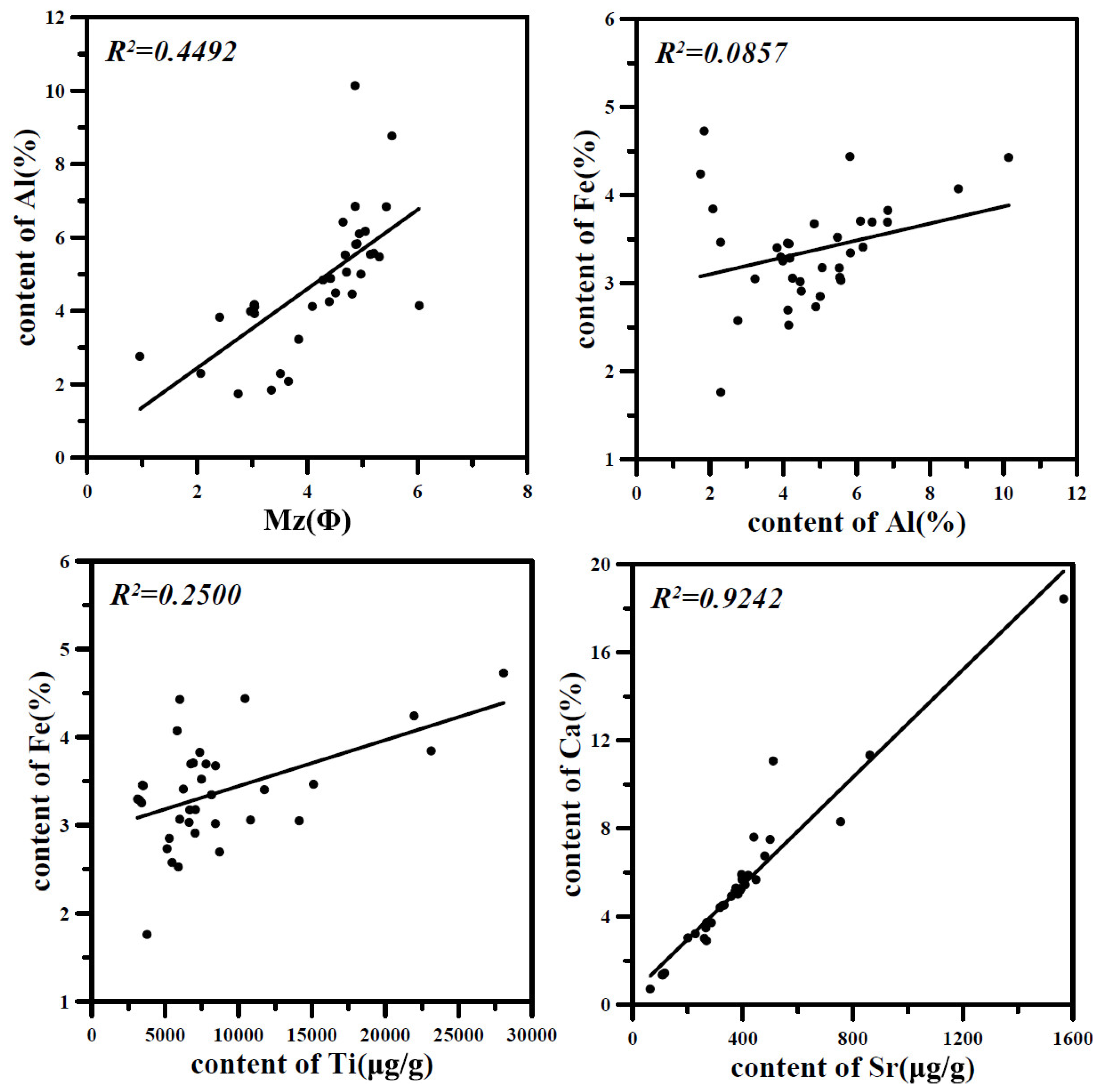
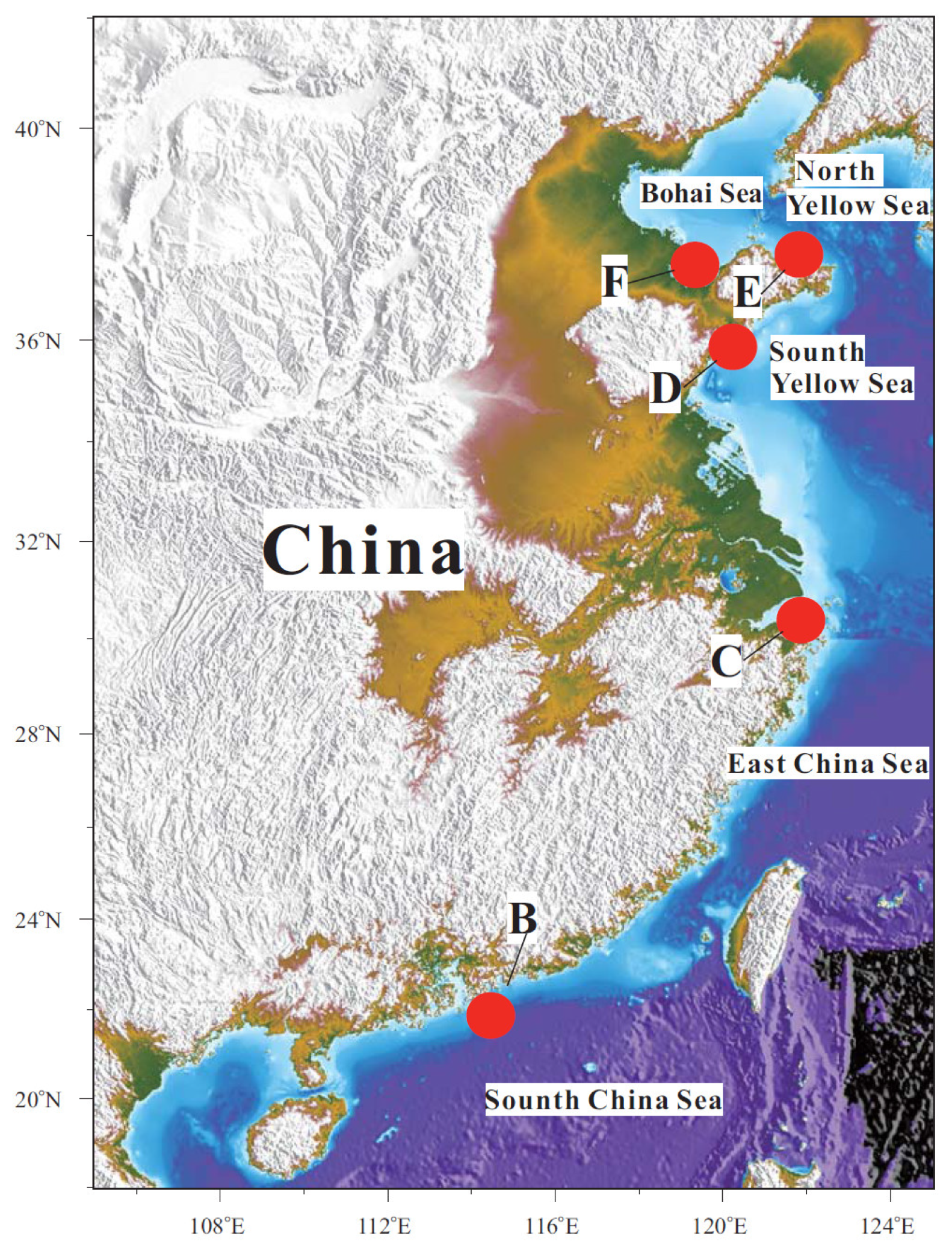
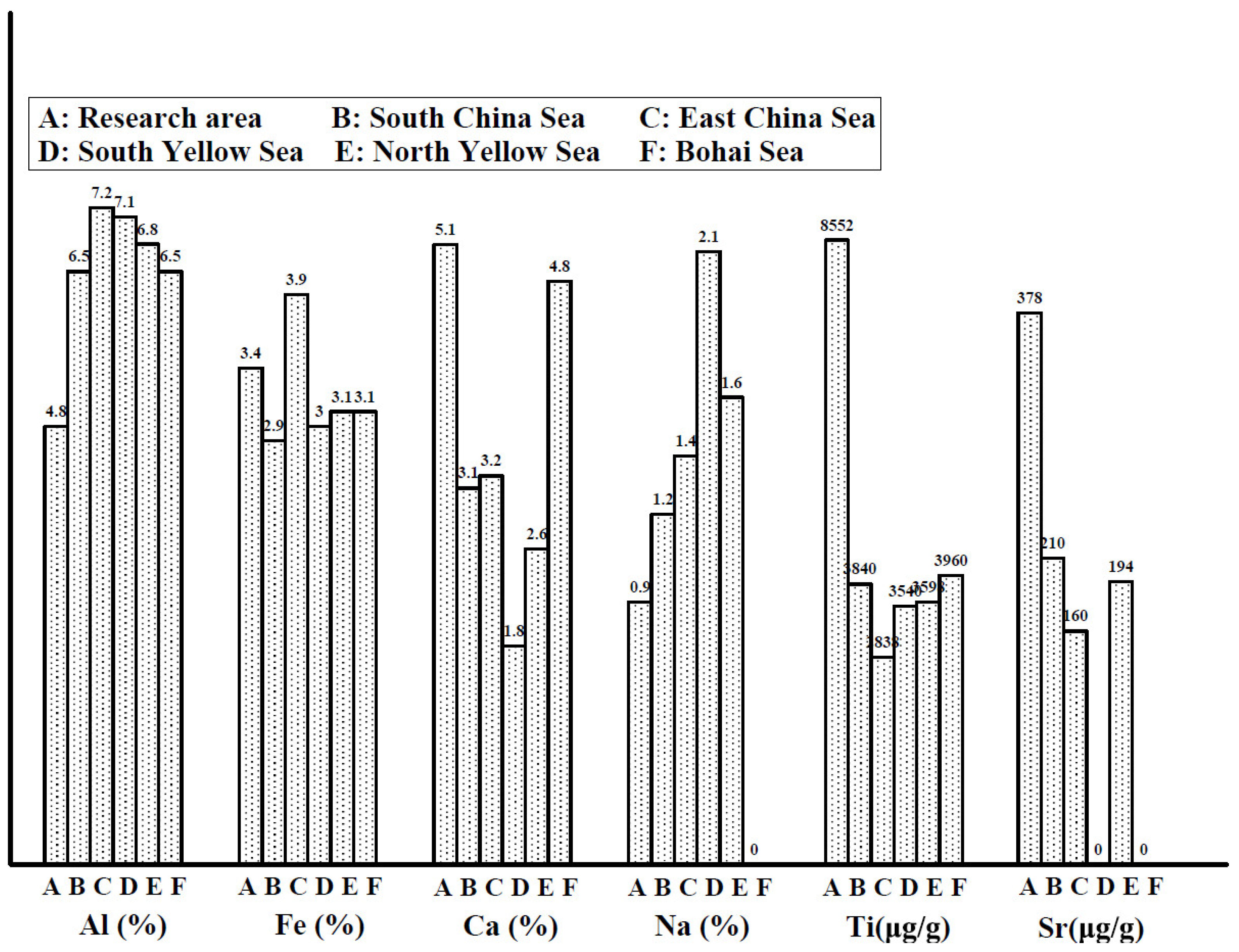
| Content of Fractions (%) | Particle Size Parameters | ||||||
|---|---|---|---|---|---|---|---|
| Clay | Silt | Sand | Mz(φ) | δ | Sk | Ku | |
| Max | 9.79 | 77.66 | 99.47 | 6.03 | 2.74 | 1.91 | 3.34 |
| Min | 0.00 | 0.53 | 12.60 | 0.96 | 0.57 | −1.37 | 0.72 |
| Ave | 4.66 | 41.57 | 53.31 | 4.15 | 1.75 | 0.80 | 2.32 |
| STD | 3.55 | 22.50 | 25.10 | 1.13 | 0.60 | 0.96 | 0.72 |
| C. V. (%) | 76.08 | 54.14 | 47.08 | 27.30 | 33.99 | 120.36 | 31.29 |
| Elements | Research Area | China Sea | ||||||||
|---|---|---|---|---|---|---|---|---|---|---|
| Max | Min | Ave | STD | C.V.(%) | South China Sea | East China Sea | South Yellow Sea | North Yellow Sea | Bohai Sea | |
| Al * | 10.1 | 1.7 | 4.8 | 1.8 | 38.3 | 6.5 | 7.2 | 7.1 | 6.8 | 6.5 |
| Mg * | 1.6 | 0.3 | 1.1 | 0.3 | 25.1 | 1.1 | 1.5 | 1.1 | 1.4 | 1.4 |
| Fe * | 4.7 | 1.8 | 3.4 | 0.6 | 17.8 | 2.9 | 3.9 | 3.0 | 3.1 | 3.1 |
| K * | 0.6 | 0 | 0.3 | 0.1 | 49.2 | 1.7 | 2.2 | 2.3 | 2.1 | 2.1 |
| Ca * | 18.4 | 0.7 | 5.1 | 3.4 | 66 | 3.1 | 3.2 | 1.8 | 2.6 | 4.8 |
| Na * | 2.2 | 0.3 | 0.9 | 0.5 | 50 | 1.2 | 1.4 | 2.1 | 1.6 | 0.0 |
| Ti | 28,064.3 | 3124.5 | 8551.8 | 5714.1 | 66.8 | 3840.0 | 2838.0 | 3540.0 | 3598.0 | 3960.0 |
| P | 1221.8 | 330 | 670.9 | 229.3 | 34.2 | 480.3 | 279.4 | 523.9 | 586.0 | 393.0 |
| Mn | 1159.2 | 227.2 | 541.1 | 187.6 | 34.7 | 542.3 | 565.5 | 774.6 | 637.0 | ** |
| Sr | 1566.1 | 63.5 | 378.2 | 266.9 | 70.6 | 209.7 | 159.9 | ** | 194.4 | ** |
| Ba | 137.1 | 6.8 | 81.2 | 35.9 | 44.2 | ** | 426.9 | ** | 457.0 | ** |
| Li | 105.7 | 8.9 | 47.1 | 20.6 | 43.8 | ** | ** | 39.3 | 38.4 | ** |
| Zn | 101.9 | 10.1 | 42.5 | 16.6 | 39.1 | 71.1 | 86.3 | ** | 80.6 | ** |
| Sc | 12.9 | 3 | 8.1 | 2.5 | 30.4 | ** | ** | ** | 11.7 | ** |
| Co | 17.9 | 3.4 | 8.1 | 2.7 | 33.6 | ** | 14.9 | 12.0 | 13.2 | ** |
| Rb | 25.4 | 0.7 | 9.6 | 5.8 | 60.1 | ** | ** | ** | 113.2 | ** |
| Th | 14.6 | 1.9 | 8.3 | 3.3 | 40 | ** | ** | ** | ** | ** |
| Mz | Clay | Silt | Sand | Al | Mg | Fe | K | Ca | Na | Ti | P | Mn | Sr | Ba | Li | Zn | Sc | Co | Rb | Th | |
|---|---|---|---|---|---|---|---|---|---|---|---|---|---|---|---|---|---|---|---|---|---|
| Mz | 1.00 | ||||||||||||||||||||
| Clay | 0.91 | 1.00 | |||||||||||||||||||
| Silt | 0.93 | 0.91 | 1.00 | ||||||||||||||||||
| Sand | −0.91 | −0.93 | −0.99 | 1.00 | |||||||||||||||||
| Al | 0.67 | 0.68 | 0.59 | −0.60 | 1.00 | ||||||||||||||||
| Mg | 0.50 | 0.48 | 0.38 | −0.39 | 0.84 | 1.00 | |||||||||||||||
| Fe | 0.17 | 0.07 | 0.13 | −0.10 | 0.29 | 0.41 | 1.00 | ||||||||||||||
| K | 0.77 | 0.81 | 0.80 | −0.82 | 0.91 | 0.71 | 0.28 | 1.00 | |||||||||||||
| Ca | −0.30 | −0.02 | −0.05 | −0.02 | −0.23 | −0.24 | −0.22 | −0.03 | 1.00 | ||||||||||||
| Na | 0.57 | 0.73 | 0.61 | −0.66 | 0.86 | 0.68 | 0.21 | 0.88 | 0.18 | 1.00 | |||||||||||
| Ti | −0.14 | −0.21 | 0.00 | 0.03 | −0.48 | −0.49 | 0.50 | −0.23 | 0.13 | −0.35 | 1.00 | ||||||||||
| P | 0.53 | 0.68 | 0.58 | −0.63 | 0.86 | 0.74 | 0.31 | 0.88 | 0.22 | 0.95 | −0.32 | 1.00 | |||||||||
| Mn | 0.19 | 0.18 | 0.28 | −0.25 | −0.18 | −0.32 | 0.33 | 0.05 | −0.03 | −0.10 | 0.61 | −0.10 | 1.00 | ||||||||
| Sr | −0.34 | −0.04 | −0.08 | 0.00 | −0.23 | −0.21 | −0.16 | −0.04 | 0.96 | 0.19 | 0.16 | 0.24 | −0.08 | 1.00 | |||||||
| Ba | 0.72 | 0.66 | 0.77 | −0.76 | 0.74 | 0.57 | 0.27 | 0.91 | −0.11 | 0.63 | −0.07 | 0.66 | 0.13 | −0.13 | 1.00 | ||||||
| Li | 0.68 | 0.74 | 0.61 | −0.64 | 0.96 | 0.84 | 0.29 | 0.90 | −0.10 | 0.91 | −0.45 | 0.90 | −0.14 | −0.10 | 0.66 | 1.00 | |||||
| Zn | 0.43 | 0.43 | 0.29 | −0.30 | 0.67 | 0.63 | 0.28 | 0.53 | −0.35 | 0.55 | −0.38 | 0.52 | −0.05 | −0.32 | 0.37 | 0.69 | 1.00 | ||||
| Sc | 0.46 | 0.44 | 0.59 | −0.57 | 0.41 | 0.24 | 0.70 | 0.63 | 0.08 | 0.47 | 0.58 | 0.50 | 0.45 | 0.10 | 0.67 | 0.41 | 0.19 | 1.00 | |||
| Co | 0.07 | 0.00 | 0.18 | −0.15 | −0.11 | −0.16 | 0.75 | 0.09 | 0.05 | −0.04 | 0.90 | 0.01 | 0.54 | 0.10 | 0.20 | −0.10 | −0.09 | 0.81 | 1.00 | ||
| Rb | 0.75 | 0.82 | 0.77 | −0.80 | 0.91 | 0.69 | 0.28 | 0.98 | 0.00 | 0.93 | −0.26 | 0.91 | 0.05 | −0.01 | 0.81 | 0.94 | 0.59 | 0.61 | 0.07 | 1.00 | |
| Th | 0.68 | 0.69 | 0.80 | −0.80 | 0.62 | 0.42 | 0.46 | 0.86 | 0.09 | 0.68 | 0.25 | 0.70 | 0.37 | 0.07 | 0.84 | 0.64 | 0.34 | 0.89 | 0.49 | 0.83 | 1.00 |
| Elements | Factor 1 | Factor 2 | Factor 3 | Elements | Factor 1 | Factor 2 | Factor 3 |
|---|---|---|---|---|---|---|---|
| Al | 0.95 | −0.09 | −0.22 | Sr | 0.00 | 0.00 | 0.97 |
| Mg | 0.82 | −0.17 | −0.28 | Ba | 0.79 | 0.29 | −0.07 |
| Fe | 0.30 | 0.71 | −0.27 | Li | 0.97 | −0.08 | −0.11 |
| K | 0.96 | 0.15 | 0.00 | Zn | 0.64 | −0.09 | −0.42 |
| Ca | −0.01 | −0.01 | 0.98 | Sc | 0.52 | 0.83 | 0.11 |
| Na | 0.94 | −0.04 | 0.20 | Co | −0.02 | 0.96 | 0.07 |
| Ti | −0.38 | 0.90 | 0.15 | Rb | 0.97 | 0.12 | 0.03 |
| P | 0.95 | 0.00 | 0.23 | Th | 0.75 | 0.57 | 0.12 |
| Mn | −0.11 | 0.72 | −0.04 | ||||
| Variance/% | 48.69 | 23.14 | 14.36 | Variance/% | 48.69 | 23.14 | 14.36 |
Disclaimer/Publisher’s Note: The statements, opinions and data contained in all publications are solely those of the individual author(s) and contributor(s) and not of MDPI and/or the editor(s). MDPI and/or the editor(s) disclaim responsibility for any injury to people or property resulting from any ideas, methods, instructions or products referred to in the content. |
© 2024 by the authors. Licensee MDPI, Basel, Switzerland. This article is an open access article distributed under the terms and conditions of the Creative Commons Attribution (CC BY) license (https://creativecommons.org/licenses/by/4.0/).
Share and Cite
Hu, M.; Zhu, Y.; Chen, W.; Yu, B.; Zhang, P.; Hu, C.; Jin, R. Investigating the Element Geochemical Behavior and Provenance of Surface Sediments in the Offshore Area of Sierra Leone, Africa: Insights from Major and Trace Elements. Water 2024, 16, 3540. https://doi.org/10.3390/w16233540
Hu M, Zhu Y, Chen W, Yu B, Zhang P, Hu C, Jin R. Investigating the Element Geochemical Behavior and Provenance of Surface Sediments in the Offshore Area of Sierra Leone, Africa: Insights from Major and Trace Elements. Water. 2024; 16(23):3540. https://doi.org/10.3390/w16233540
Chicago/Turabian StyleHu, Mengying, Yingtao Zhu, Wenliang Chen, Bin Yu, Pengpeng Zhang, Chuanqi Hu, and Ruijia Jin. 2024. "Investigating the Element Geochemical Behavior and Provenance of Surface Sediments in the Offshore Area of Sierra Leone, Africa: Insights from Major and Trace Elements" Water 16, no. 23: 3540. https://doi.org/10.3390/w16233540
APA StyleHu, M., Zhu, Y., Chen, W., Yu, B., Zhang, P., Hu, C., & Jin, R. (2024). Investigating the Element Geochemical Behavior and Provenance of Surface Sediments in the Offshore Area of Sierra Leone, Africa: Insights from Major and Trace Elements. Water, 16(23), 3540. https://doi.org/10.3390/w16233540







